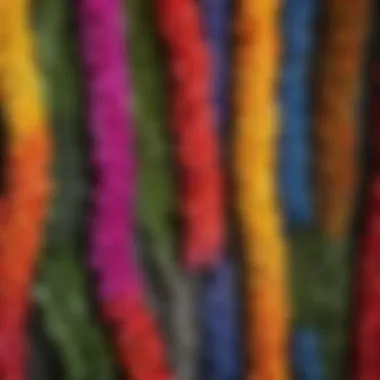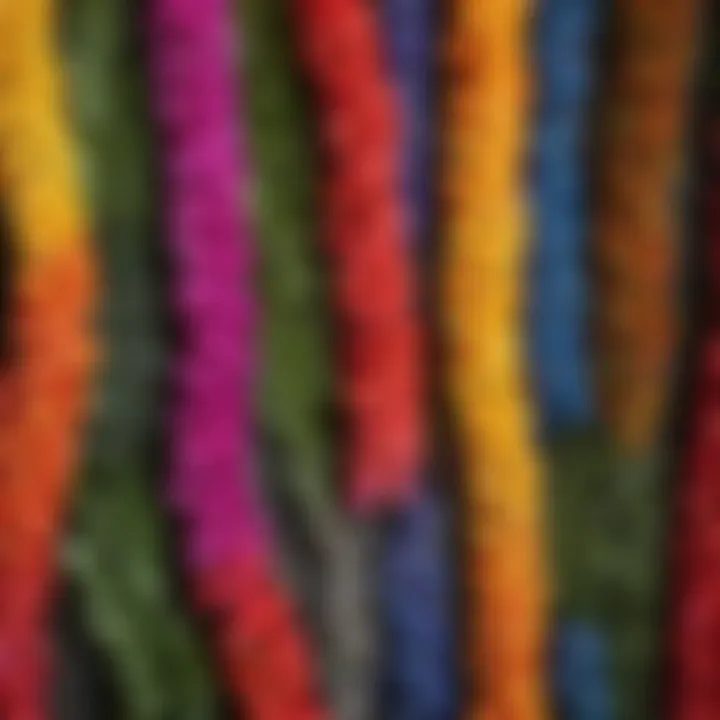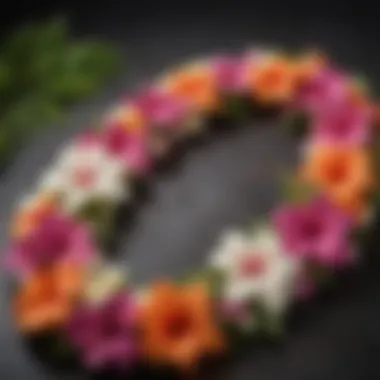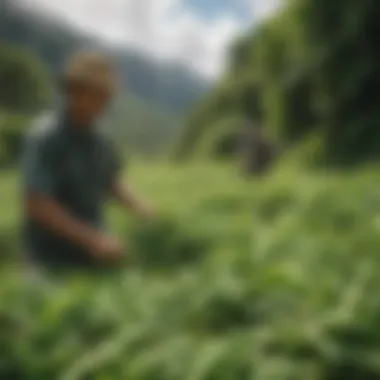Understanding the Cultural Significance of the Hawaii Lei


Intro
Hawaii’s lei plant is more than just a visual treat. It intertwines deeply with the island’s cultural fabric, symbolizing love, respect, and tradition. As one of the most cherished aspects of Hawaiian heritage, the lei transcends mere decoration; it tells stories, conveys feelings, and connects people to their roots. In this article, we will walk through the various intricacies surrounding this beautiful plant, especially its significance in Hawaiian water sports culture and its practical uses.
Techniques and Skills
Crafting a lei requires not just skill but a deep understanding of the plants themselves.
Fundamental Techniques for Beginners
Starting out doesn’t have to be a daunting task. Here are some basic techniques to get your lei-making journey underway:
- Selecting the Right Flowers: Commonly used flowers include plumeria, hibiscus, and maile. Each flower carries its significance and fragrance.
- Basic Knotting Methods: The traditional lei often involves simple techniques like the single knot and double knot. Mastery of these will set a solid foundation.
- Using a Needle: Infusing artistic elements can come in handy with a needle and thread, especially for flowers that have thicker stems.
Advanced Skills for Experienced Artisans
Once you're comfortable with the basics, you can delve into more innovative styles. This could involve:
- Layering Techniques: To add depth and character to your lei, learn how to layer different types of flowers—this could include alternating colors for a striking effect.
- Incorporating Greens: Many artisans incorporate foliage like ti leaves or ferns. This not only enhances the visual attractiveness but also strengthens the structure.
- Practical Patterns: Create patterns known as haku for a more sophisticated creation, tying multiple flowers together in a rhythmic sequence.
"A lei is a symbol of aloha, a representation of warmth, compassion, and connection."
By honing these skills, the artistry of the craft can come through, allowing the maker to express their individuality while honoring Hawaiian traditions.
Safety and Gear
When engaging with the process of lei-making, especially in natural settings, safety should never be an afterthought.
Essential Safety Measures in Watersports
Hawaii's waters are both inviting and unpredictable. If you’re participating in water sports while sporting a lei or engaging in events where the lei plants are harvested, keep these safety measures in mind:
- Stay Hydrated: The sun is strong, so always carry water to stay hydrated.
- Check Local Regulations: Some lei plants may be protected; harvesting them might violate local laws.
- Be Aware of Your Surroundings: Whether swimming, kayaking, or canoeing, always have an eye on the weather conditions and water activity.
Gear Reviews and Recommendations
While the primary focus is on the lei plants, choosing the right gear for water sports can enhance the entire experience:
- Life Jackets: A good quality life jacket is essential for safety while in and around water.
- Sunscreen: Protecting your skin from harmful rays is just as vital. Look for water-resistant options with high SPF.
- Water Shoes: Proper footwear protects feet from sharp rocks and coral, which can be common in some areas.
Understanding these tools and techniques brings not only a richer appreciation for lei-making but also enhances the entire experience involving water sports in Hawaii. The balance between crafting beauty and staying safe continues the Hawaiian legacy and shows respect to both the land and the sea.
Prologue to Hawaii's Lei Culture
The Hawaii lei culture is more than just a means of adornment; it represents an intricate tapestry woven with historical significance and contemporary importance. Every lei is crafted with intention, a reflection of Hawaii's rich traditions and the deep connections to the natural world.
In this section, we will explore the dual aspects of the lei: its historical context and its cultural significance. The understanding of these elements is vital for anyone seeking a comprehensive view of what leis represent and how they influence social practices and celebrations in Hawaii.
Historical Overview of the Lei
The origins of the lei can be traced back centuries, intertwined with the stories of Hawaii’s first settlers who brought their customs and traditions from Polynesia. These floral garlands were not mere accessories but held profound meanings, often serving as symbols of welcome, love, and respect. The use of natural materials such as flowers, leaves, and shells reflected the resourcefulness of the Hawaiian people, who cherished their environment.
In times gone by, the crafting of leis was often reserved for special occasions. Only those of high social standing, like aliʻi (chiefs), were adorned with complex leis made of rare and fragrant flowers. Over the years, as cultural practices evolved, leis became accessible to all, symbolizing a communal spirit where everyone could partake in celebrations, fostering connections among the people.
Cultural Significance of the Lei


Today, leis occupy a special place in Hawaiian culture, serving various roles during significant life events. From the joyful welcome ceremonies for visitors to graduation celebrations, leis articulate feelings of love, gratitude, and fellowship. They are given as not just gifts, but also as heartfelt gestures that communicate a deeper sense of connection.
The symbolism of the lei transcends mere aesthetics; each type may convey different meanings. For instance, a lei of maile represents peace and is often used in weddings, while the vibrant hues of hibiscus could symbolize beauty and unity.
Moreover, the practice of giving and receiving leis connects people across generations, embodying a sense of belonging and identity that is integral to the Hawaiian way of life.
"A lei is a reflection not just of native flora, but of the spirit of Aloha itself—one that thrives on relationships and the beauty of connection."
In summary, the lei serves as a vital link between the past and present, illustrating the themes of respect, love, and community through its intricate designs and diverse forms. Understanding its historical roots and cultural significance is essential for anyone looking to appreciate the full spectrum of Hawaii’s vibrant traditions.
Identifying the Key Lei Plants
In the heart of Hawaiian culture, the lei is not merely a garland of flowers; it’s a symbol, an expression, an art form. Recognizing the plants that form the foundation of these leis is crucial not only for appreciating their cultural significance but also for understanding the ecological considerations inherent in harvesting them. Identifying the key lei plants serves multiple purposes. It informs lei makers and enthusiasts about what plants are traditionally used, their seasonal availability, and the best practices for sustainable harvesting. Ultimately, these insights ensure that the beauty of the lei continues to flourish in Hawaiian culture.
Traditional Plants Used for Leis
Plumeria
Plumeria, often known for its captivating fragrance, is a staple in lei-making. Its vibrantly colored flowers not only offer aesthetic appeal but also hold deep cultural significance. This plant thrives in warm climates, making it a popular choice for leis year-round. Its unique feature lies in the waxy texture of the petals, giving them a remarkable longevity when strung into leis. This makes Plumeria a favored option for visitors looking to bring home a piece of Hawaii that lasts.
On the flip side, while Plumeria is widely adored, it requires careful handling. Once plucked, the flowers need to be used quickly since they tend to wilt. Therefore, some might find its temporary nature a challenge, especially for events that require longer-lasting presentation.
Tuberose
Tuberose stands out for its robust, enchanting scent. The flowers are small and tubular, tightly packed on long spikes. Their striking white hue adds elegance to any lei, often making them a preferred choice for formal occasions. This particular plant has roots that traditionally connect to celebrations of love and affection, giving the lei a profound emotional layer.
However, Tuberose can be a bit tricky when it comes to local availability. It might not be as accessible as Plumeria at certain times of the year. Despite this, its unique fragrance and historic importance frequently position it as a beloved choice for lei-making that conveys deep meaning.
Hibiscus
Hibiscus, with its large, showy blossoms, is another iconic plant used in lei-making. Its bold colors can brighten up any arrangement, making the lei an eye-catching accessory for many occasions. This flower, often associated with beauty and delicate nature, has the added advantage of being easily accessible throughout Hawaii.
Yet, its large size can also be a disadvantage; when making leis, balancing the Hibiscus with smaller flowers can be a challenge. The petals, while stunning, are relatively short-lived, which means Hibiscus leis may require a quick turnover for events.
Maile
Maile is unique among the lei plants as it is not just a flower but a fragrant vine. Its significance goes beyond aesthetics; in Hawaiian culture, Maile represents peace and love, and it’s commonly used in ceremonial leis. The leaves boast a rich green color, and when braided, they provide a stunning contrast against the vivid colors of other flowers used in leis. Maile leis are often reserved for special occasions, such as weddings and graduations, reflecting their cultural weight.
The downside is that Maile is sometimes less accessible than more common flowers. It requires specific growing conditions and is particularly sensitive to overharvesting. This makes it essential for lei makers to practice sustainable harvesting to ensure the future availability of this cherished plant.
Emerging Plants in Lei-making
Orchid Varieties
Orchids, especially those native to Hawaii, have become popular in the realm of lei-making. Known for their intricate, exotic bloom patterns, these flowers bring a touch of elegance. They come in a vast range of colors and styles, allowing for considerable creativity in lei designs. Their long-lasting nature when cut makes them an appealing option, often outlasting many traditional flowers.
Despite their beauty, some orchids require particular conditions for growing. Not all lei makers might have the means to cultivate them effectively, leading to potential sourcing problems.
Foliage Additions
The incorporation of foliage has gained traction in lei-making. Leaves, herbs, and greens not only serve as a backdrop for the flowers but also add texture and depth to the design. Using local foliage allows for sustainable creative expression. Notably, certain leaves, like those from the ti plant, are traditionally significant, often embodying cultural meanings.
However, the challenge with foliage lies in achieving harmony with the flowers. If not balanced well, they might overshadow the blooms rather than complement them.
Exotic Flora


Beyond traditional choices, the inclusion of exotic flora from other regions has opened new pathways in lei-making. Flowers from various parts of the world can now add rarity and intrigue to the leis. These exotic varieties bring fresh colors and fragrances, appealing to adventurous lei makers willing to experiment with new designs.
The downside? Availability often fluctuates. Sourcing exotic plants can sometimes lead to higher costs and potential issues with sustainable harvesting. Practitioners must ensure they are sourcing responsibly to maintain ecological balance.
Identifying these key plants provides a framework for both appreciating and crafting the beautiful leis that symbolize Hawaiian culture. Each plant carries with it stories and responsibilities that reflect the vibrancy of Hawaiian heritage.
Harvesting Techniques
Sustainable Harvesting Practices
Sustainable harvesting practices are essential for preserving the beauty and availability of lei plants. This concept revolves around gathering plants in ways that do not deplete the source. A common approach among local harvesters is to select only specific flowers from a plant rather than stripping an entire bush. For instance, during the plumeria harvest, only a few blooms are removed, allowing the plant to continue thriving.
Considerations like the time of day also come into play. Early morning or late afternoon is typically when the flowers are fully hydrated and fragrant, enhancing their beauty and longevity when used in leis.
Moreover, tools such as sharp scissors or pruners are used to minimize damage to the plant. By making clean cuts, harvesters help ensure that plants can heal and continue growing.
In essence, the goal of these practices is to maintain ecological balance, which is critical not just for the plants but also for the ecosystem that supports them. People buying leis made from sustainably harvested materials find it significant, often forming a deeper connection to the culture and environmental responsibility of the islands.
Seasonality and Plant Lifecycles
Understanding the seasonality and lifecycles of lei plants is crucial for optimal harvesting. Different lei plants bloom at varying times of the year. For example, orchids bloom during the warmer months, whereas maile is typically harvested in the winter.
This seasonal awareness allows harvesters to time their efforts so that flowers are abundant and in full bloom. Knowing when a plant is at its peak also helps preserve its integrity and fragrance, factors that are important for creating a stunning lei.
Leis often incorporate elements from plants that possess distinct lifecycles. The longevity of certain flowers, like tuberose, can vary significantly, and gathering them at the right time ensures freshness. Additionally, some plants can only be harvested during certain moon phases according to cultural beliefs.
The connection between seasons and plant growth deepens the appreciation for these natural beauties. Such knowledge not only enriches the lei-making experience but also serves as a reminder of the cyclical nature of life in Hawaii. By incorporating seasonality into the harvesting techniques, artisans also align with cultural traditions, honoring their ancestors who practiced similar methods.
"To walk in harmony with the plants is to understand their language, and in turn, share their beauty with the world."
Art of Lei-making
The art of lei-making is a cherished tradition in Hawaiian culture, embodying both creativity and cultural identity. Each lei is more than a mere garland; it is a rich reflection of Hawaii's history, customs, and the natural beauty that surrounds its islands. The techniques employed in making leis and the symbolism intertwined within their design are essential elements of this art form, which resonate deeply with both locals and visitors alike.
Techniques and Traditions
Creating a lei requires a unique blend of skill, knowledge, and passion. It’s not simply about stringing flowers together; it involves understanding the specific plants that are traditionally used, their seasonal availability, and how to arrange them harmoniously. In Hawaiian culture, various techniques are passed down through generations—each family may have its own secret way of crafting these floral adornments.
Here are some crucial techniques often utilized in creating a lei:
- Threading: Involves sewing or stringing flowers together using needle and thread or fishing line. This method ensures durability and allows for more intricate designs.
- Braiding: This technique uses leaves or stems to create a robust structure, making the lei more resilient—as the leaves of the maile plant exemplify resilience and kinship.
- Twisting: A method where petals are twisted around each other, akin to intertwining lives, highlighting the connection between the giver and the recipient.
Tradition plays a significant role in this art. Certain leis are made for specific events, such as graduations, weddings, or to welcome someone home, which enhances their emotional value. These customs also serve as teaching moments, where local knowledge about flora and fauna is shared with the younger generation.
Symbolism within Lei Designs
Each lei tells a story; the symbolism embedded within its design is profound. Colors, shapes, and the choice of flower all carry significant meanings that may vary among families or islands. For example:
- Plumeria: Often symbolizes creation and new beginnings. It represents the beauty of spirit and changes in life.
- Tuberose: This flower is not just fragrant but signifies love and sensuality, making it a popular choice for romantic occasions.
- Maile: Considered sacred, it is symbolic of peace and friendship, often used in leis for welcoming ceremonies.
"In Hawaiian culture, a lei is not just a gift but an extension of one's spirit and emotional offering."
A lei may also incorporate various colors, each reflecting different emotions or wishes. Bright and vibrant hues might symbolize joy, while earthy tones could express grounding and connection to nature. The arrangement of flowers, too, carries significance; a well-crafted lei demonstrates the care and intent of the maker, reflecting their bond to the recipient.
In essence, the art of lei-making encapsulates the heart of Hawaiian traditions, merging natural beauty with deep cultural significance. Through the techniques employed and the symbolic meanings woven into each design, the lei becomes a bridge between generations, telling tales of love, honor, and community.


The Lei and Water Sports
Water sports in Hawaii and leis have a unique bond, one that intertwines celebration with the rich heritage of the islands. The vibrant display of flowers that adorns the necks not only signifies welcome and aloha but also accentuates the experiences shared during water-themed activities.
Lei as a Symbol of Celebration
Leis are more than mere ornaments; they embody a spirit of celebration that resonates deeply during water sports events. Whether it’s a surfing competition or a leisurely day spent kayaking, a lei is often presented as a gesture of goodwill to participants.
Imagine a reggae festival by the beach, where surfers compete amidst cheerful crowds. As each athlete takes to the waves, they often receive a lei, often made of local flowers like blossoms from the plumeria tree. This act is laden with meaning; it celebrates not just the individual’s skills but also the shared joy of the event. The act of draping a lei over someone’s neck comes with traditions, reminding participants that they are part of a community bound by respect for nature and sport.
Moreover, tough surf contests may not seem like the right backdrop for gentle flower garlands, yet such contrasts make the lei's presence even more poignant. It becomes a reminder that while the competition heats up, the spirit of aloha remains at the core of these activities.
Leis in Competitions and Festivals
In various competitions and festivals held across Hawaii, leis are prominently featured and carry different significances depending on the context. For instance, they often mark the commencement of competitions, signifying a good start and encouraging camaraderie among competitors.
At the annual “Merrie Monarch Festival,” for instance, which showcases hula and cultural celebrations by the ocean, leis are integral to the spectacle. Participants adorn themselves with intricately woven garlands, presenting not just beauty, but a rich tapestry of stories and heritage in each flower. Events like these thrive on the energy and enthusiasm generated by the leis, amplifying not just individual achievement but cultural pride as well.
In the context of water sports like canoe racing, not only do participants wear leis, but they also honor their guiding spirit with lei offerings. Competitors often throw their leis into the water, symbolizing both gratitude and respect for the ocean that sustains them. This act of homage serves as a reminder that while the competition may be fierce, the ocean remains a shared sustainer for all—bringing everyone together in the spirit of aloha.
"The lei symbolizes not just victory, but the relationship between man and the ocean, a connection that runs deep in Hawaiiana."
Thus, leis are a vivid thread in the fabric of water sports culture in Hawaii, embodying celebration, respect, and community connections. They serve both as beautiful adornments and as powerful symbols, connecting the past with the present, and the individual with the collective, firmly rooted in Hawaiian tradition.
Environmental Considerations
When discussing the intricate world of Hawaii's lei plants, we must turn a discerning eye to the environmental aspects surrounding their cultivation and harvesting. This part of the article highlights not only the ecological significance of these plants but also underlines the delicate balance needed to preserve them. Aiming for sustainability in lei-making practices is paramount, especially given the cultural reverence for these floral garlands. It’s a starting point to understanding the heart of the issue.
Impact of Overharvesting
Overharvesting can have dire consequences on the native flora of Hawaii. As more individuals and commercial enterprises seek to create stunning leis for various occasions, the demand places immense pressure on certain plants. Popular varieties like Plumeria and Tuberose face the brunt of this challenge. With a growing population and tourism influx, the need for luxurious leis can escalate, potentially leading to their extinction.
The lei isn't merely decorative; it holds deep cultural significance and offers ecological benefits, such as helping to maintain soil health and providing habitats for other species. The unwanted side effect of unsustainable practices? A decline in biodiversity. In extreme instances, particular plants become less common in their native habitats, hampering the ecosystem's balance.
Strategies for mitigating these impacts are crucial. Many advocates emphasize the importance of educating local communities and tourists alike about sustainable harvesting techniques. This involves understanding the growth cycles of plants and only taking portions that allow for regrowth. Preservation is not just about stopping the act of harvesting but ensuring it can be done responsibly.
Conservation Efforts in Hawaii
As the strain on Hawaii's natural resources becomes increasingly evident, a number of conservation efforts have emerged to protect the lei plants. Organizations on the island are working tirelessly to secure the future of these beloved flora. One prominent initiative involves community planting events, where locals gather to cultivate native species that have dwindled due to overharvesting and habitat destruction.
Additionally, educational programs are implemented in schools and communities. These programs highlight the importance of biodiversity, the roles each plant plays in the ecosystem, and the cultural significance of lei plants within Hawaiian society.
Another vital aspect is collaboration between local governments, non-profit organizations, and even businesses. For instance, there has been a push to create sustainable lei-making workshops that empower local artisans. Attendees learn to make leis using locally sourced flora, ensuring that the plants used are abundant and sustainable, while also embracing traditional methods.
Advocates stress that conservation is a shared responsibility. With ecology changing and the pressures of modern life on the environment, everyone who loves and cherishes the beauty of Hawaii must take steps to preserve it. Through advocacy, education, and community efforts, the future of the lei plant can remain bright, preserving its essence for generations to come.
The End
As we draw to a close on our exploration of the Hawaii lei plant, it’s essential to reflect on the multifaceted importance of these floral garlands in both ecological and cultural contexts. The lei is not merely a decorative adornment; it symbolizes deep-rooted traditions, respect, and a connection to the land. The future of the lei plant in Hawaiian culture hinges on understanding its heritage and advocating for sustainable practices in harvesting.
The Future of the Lei Plant in Hawaiian Culture
Looking ahead, the lei plant's role in Hawaiian culture will likely evolve alongside changing societal values and environmental challenges. Cultural preservation is more important than ever, as young generations are seeking to understand their identity and roots. In this journey, the lei plant, with its variety of species, can serve as a pivotal bridge to the rich history of Hawaii.
Innovative approaches are emerging to incorporate more sustainable practices in lei-making, particularly as awareness grows surrounding overharvesting concerns. Educating both locals and visitors about proper harvesting techniques is crucial. Some community programs even encourage the planting of native plants, thereby fostering an environment of growth rather than depletion.
In addition, as tourism continues to play a significant role in Hawaii's economy, the way leis are perceived by visitors is also changing.
- Visitors are increasingly drawn to authentic experiences that connect them to the land and culture.
- They seek to understand the stories behind the plants and the artisans who craft these beautiful offerings.
Thus, the lei plant serves both a cultural and an environmental purpose, acting as a reminder of the intricate balance between nature and heritage. The emphasis on long-term sustainability, coupled with the collective pride in Hawaiian culture, offers a path forward that respects tradition while embracing modernity.
"The lei is a symbol of love, connection, and respect, potent in its simplicity but profound in its legacy."















